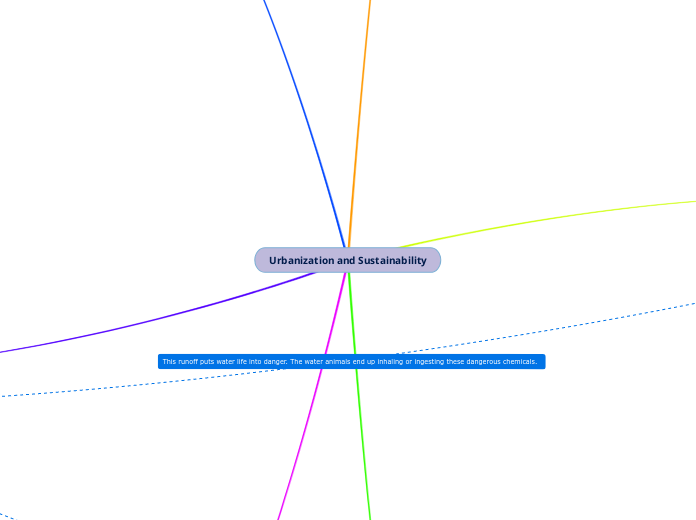Urbanization and Sustainability
Air Pollution
Air pollution is the contamination of the environment by a chemical or physical change that modifies the characteristics of the earth’s natural atmosphere.
Urbanization is causing more air pollution as most of this type pollution is caused by motor vehicles, industrial facilities and forest fires.
This outdoor pollution is causing strokes, heart diseases, lung cancer, acute/respiratory diseases
There are also 2.4 billion people exposed to dangerous levels of household air pollution. This happens in ways such as
using polluting open fires or simple stoves for cooking fueled by kerosene, biomass (wood, animal dung and crop waste), and coal.
Ambient air pollution/household air pollution lead to over 7 million premature deaths every year
Solution #1:
Reduce the number of trips you take in your car.
Take public transit.
Carpool with others.
Solution #2:
Switch to electric or hand powered lawn equipment.
Solution #3:
Reduce fireplace and wood stove use.
Image of Air Pollution
Water Pollution
Water pollution is the contamination of waterbodies which is usually caused by human activity.
Water pollution makes the water unusable for cooking, cleaning, drinking, swimming and other activities.
These pollutants include things such as trash, bacteria, parasites and chemicals.
Water pollutants can cause disease and health issues such as cholera if you have drank improperly water.
If chemicals from water pollutants come in contact with your skin by swimming or washing your clothes with polluted waste, it can cause severe skin irritation.
Urbanization is increasing the amount of water pollution rapidly because of the number of waste we humans produce every day.
The runoff from streets carries oils, rubber and other contaminants from vehicles. This easily goes into our water bodies and contaminates them.
Solution #1:
Stop littering and dispose garbage in the correct places.
Solution #2:
Sweep fertilizer back into the grass before it gets into paved areas.
This will prevent chemicals getting into groundwater.
Solution #3:
Wash your car in an area where the water and chemicals can flow to a gravel or grassy place instead of a street.
Image of Water Pollution
Land Pollution
Land pollution is referred to the deterioration of of the earth’s land surfaces.
This is commonly caused by the accumulation of solid and liquid waste materials which negatively impact the soil and groundwater.
Urbanization is increasing the amount of land pollution produced due to the high demand in producing non renewable energy sources, waste production and transportation.
Insufficient garbage collection systems also contribute to land pollution.
Garbage is always dumped in a landfill. Sometimes some communities produce too much waste which causes landfills to fill up and they end up running out of places to dump their waste.
Trash and litter is a common form of land pollution.
Solution #1:
Consumers should purchase organic products.
Solution #2:
Governments should make renewable energy sources the main source of energy available.
Solution #3:
Plant solar panels on every building.
Solution #4:
Companies should make product packaging eco friendly .
Image of Land Pollution
Deforestation
Image of Deforested Land
Deforestation is the removal of trees/forests.
This is done to convert the land into non-forest uses such as more room for agricultural land, more room for houses in an urban setting and construction.
Due to urbanization, humans are deforesting forests faster than ever before.
There are only about half the amount of trees left on the planet compared to when humans first evolved.
Deforestation is the cause for 10% of global warming. If deforestation isn’t stopped, we will never be able to combat climate change efficiently.
Solution #1:
Reduce paper consumption.
Solution #2:
Plant as many trees as you can.
Solution #3:
Build homes in an efficient manner so that they take up less space.
Apartments/townhouses
Biodiversity Loss
Image of Biodiversity Loss
Biodiversity is the variety of life you find on earth
Urbanization puts biodiversity at a great risk.
Humans are continuing to put more and more pressure on the planet and are consuming more resources than ever before.
This risks putting our diverse life species into danger.
The growth of cities contributes to major biodiversity loss by damaging and fragmenting their natural habitats.
Another threat that urbanization poses to biodiversity is relocating invasive species to new areas which threatens the native species/natural environment.
This can be done by international trade, transport and gardening.
Solution #1:
Prevent invasive species from entering unknown ecosystems/areas.
Prevent releasing plants, aquarium pets, live food or live bait into bodies of water.
Solution #2:
Reduce your carbon emissions.
Carpool with others and use public transport.
Solution #3:
Purchase sustainable and fairtrade products.
Land Degradation
Land degradation is caused by extreme weather conditions, mainly droughts.
Urbanization also causes land degradation.
Its caused by human activities such as poor farming practices and land clearance that can pollute the environment or reduce the quality of soil and land utilization.
Land degradation negatively affects food production and harms the overall environment.
Land degradation is stressing the earth’s arable lands and impacting the quality of life in certain areas.
This is causing reduced food production in areas with drought which results in residents having to move to more hospice areas.
Solution #1:
Practice responsible farming techniques.
Such as crop rotation and adding mulch on top of the soil. This helps the soil revitalize and stay healthy over the year.
Solution #2:
Plant more trees and vegetation to prevent soil erosion.
Solution #3:
Add compost or manure to the soil to help it replenish nutrients.
Image of Land Degradation
